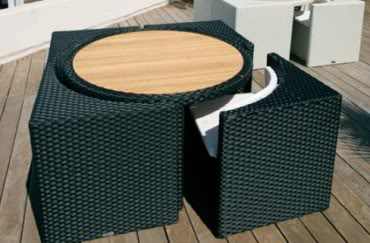Synthetic rattan is a very useful crafting material designed to be a substitute for natural rattan when its limitations are at question. It makes a perfect look-alike too. Primarily, most homeowners and office decorators want the beauty of rattan items to be displayed and used by the garden or outdoors, thus, furniture pieces made from synthetic rattan material is a must.

Among the unique and most important features of the synthetic material are:
- The ability to withstand changing or erratic weather conditions (weather resistant), the material is also resistant to UV rays and on water pressure.
- Compared to plastic and some other types of treated wood material, synthetic wicker is considered to be environment-friendly and do not pose any hazard or toxicity threat to individuals. The material may also be recycled when the rattan furniture has already been damaged or no longer usable.
- Since it is a mimic or exact copy of rattan, it exactly resembles its natural wicker counterpart. The texture and feel will generally be just the same as the natural one.
- Since synthetic wicker material is designed for the tougher conditions outdoors, the material is essentially produced to be much stronger, tougher, and more durable even at extreme temperatures.
- Like natural wicker, the synthetic ones are also easy to clean and would only require minimal maintenance or care.
- Since it is commercially produced, custom grading is also possible. Size, other measurements, specifications, and the wicker color can be pre-specified or changed.
- And the most important attribute that will determine the furniture pieces’ useful lifetime is the material’s ability to prevent infestation of pests, fungus, and other parasites.
What is synthetic rattan made of?
Commonly termed as resin, top quality polyethylene-based fiber is the main material used to create synthetic wicker material. Resin has been one of the most popular alternatives to plastic and other building and crafting materials due to its more beneficial features and attributes (some are enumerated above). During the manufacture of the synthetic wicker material, coloring is already pre-mixed with the individual fibers of resin.
The types of synthetic wicker
There are usually three general synthetic rattan materials present or sold in the market, the polyrod, polypeel, and the polystrap.
Polyrod is the counterpart of rattan poles, sticks, and wicker. Like the usual rattan poles, sticks, or wickers, it has a solid and round make or shape. The diameter size that you will have to purchase is dependent on your crafting purpose.
Polypeel on the other hand is a semi-circular material oftentimes characterized by an inner hole within its diameter.
Finally, the polystrap synthetic rattan will be the counter part of natural rattan skin which is primarily used in weaving, as rattan pole wrap, and other similar uses. It is characterized by a flatter look or wider diameter.

